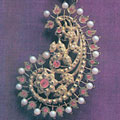Bikaner, one of the three main destinations in the tourist desert circuit of Rajasthan is known as camel country as the camels here are said to be best in the world for riding purposes. Bikaner also boasts of the largest Camel research and breeding farm in the World which was initiated by the central government. The National research center for Camel not only researches the camel, and in all its aspects – hair and milk etc.
Bikaner has also been known for the use put to camel skin including the crafting of handmade objects.
The community of dapgars process the skin of camel to make traditional Rajasthani drums and camel skin decorative items from bottles, vases, bowls etc. There is only one traditional dapgar family in Bikaner still processing the camel skin for usage. They make objects like flasks, bottles and vases from camel skin. The objects made by them are used by the well known Usta community to paint them in Gesso or Usta kaam.
With Gold motifs in high-relief combined with jewel like tones the geometric, floral and animal figures form the Usta- Kaam that can be seen architecturally ornamenting walls, pillars and ceilings of heritage homes and palaces and in Bikaner.
It is also practised on smaller objects such as saddles, boxes, vases, water carriers, lamp shades, mirror and photo frames – you name it. Here the base being moulded camel hide
Deriving its name from its maker community – the Usta’s who were invited from Multan now in Pakistan to the Mughal courts at Delhi and later in time to the court of Raja Rai Singh in Bikaner the process follows a building up of layers and patterns with the application of the glue- like gesso paint, which is then covered with gold foil and colour. While demand for interior work from luxury hotels continues for those who work with smaller objects on camel skin has declined to just 4 or 5 craftsmen.
While there are a list of reasons I highlight just one – for this craft like many others has several processes – each carried out by specialist craft communities – and it wasn’t for lack of orders – but because the community of Dapgars who plied the complex craft of moulding and stretching camel leather on clay moulds were rendered invisible in the process as any recognition on the craft was being given only to the artists while the value chain was forgotten – and they had moved on to other professions just 2 remain in practice
Gallery
YOUR VIEWS
PRACTITIONERS: INDIA
Access 70,000+ practitioners in 2500+ crafts across India.
BIBLIOGRAPHY
10,000+ listings on arts, crafts, design, heritage, culture etc.
GLOSSARY
Rich and often unfamiliar vocabulary of crafts and textiles.
SHOP at India InCH
Needs to be written.






